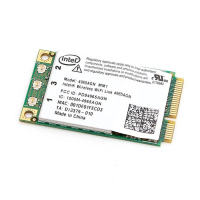Proceed to Step 4.
❍ Use the certificate issued to this computer: Proceed to Step 5.
❍ Use my smart card: Select if the certificate resides on a smart card. Proceed to Step 5.
4. User Name: Enter the user name assigned to the user certificate.
5. Click Next.
Step 2 of 3: EAP-FAST Additional Information
If you selected Use a certificate (TLS Authentication) and Use a user certificate on this computer, click
Next (no roaming identity is required) and proceed to
Step 3 to configure EAP-FAST Server certificate settings.
If you do not need to configure EAP-FAST server settings, click OK to save your settings and return to the
Profiles page.
If you selected to use a smart card, add the roaming identity, if required. Click OK to save your settings and
return to the Profiles page.
If you did not select Use a certificate (TLS Authentication), click Next to select an Authentication Protocol.
CCXv4 permits additional credentials or TLS cipher suites to establish the tunnel.
Authentication Protocol: Select either
GTC, or MS-CHAP-V2 (Default).
Generic Token Card (GTC)
GTC may be used with Server-Authenticated Mode . This enable peers using other user databases as
Lightweight Directory Access Protocol (LDAP) and one-time password (OTP) technology to be provisioned in-
band. However, the replacement may only be achieved when used with the TLS cipher suites that ensure
server authentication.
To configure a one-time password:
1. Authentication Protocol: Select GTC (Generic Token Card).
2. User Credentials: Select Prompt each time I connect.
3. On connection prompt for: Select one of the following:
Name Description
Static Password
On connection, enter the user credentials.
One-time password (OTP)
Obtain the password from a hardware token device.
PIN (Soft Token)
Obtain the password from a soft token program.
1. Click OK.
2. Select the profile on the Wireless Networks list.
3. Click Connect. When prompted, enter the user name, domain and one-time password (OTP).
4. Click OK.
MS-CHAP-V2
This parameter specifies the authentication protocol operating over the PEAP tunnel.
1. Select the user credentials:
Use Windows logon, Prompt each time I connect, or Use the following.
2. Roaming Identity: A Roaming Identity may be populated in this field or you can use %domain%\%
username% as the default format for entering a roaming identity.
When 802.1x Microsoft IAS RADIUS is used as an authentication server, the server authenticates
the device using the Roaming Identity from Intel PROSet/Wireless software, and ignores the
Authentication Protocol MS-CHAP-V2 user name. Microsoft IAS RADIUS accepts only a valid
user name (dotNet user) for the Roaming Identity. For all other authentication servers, the
Roaming Identity is optional. Therefore, it is recommended to use the desired realm (for example,

